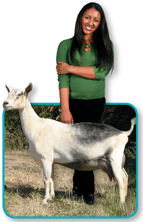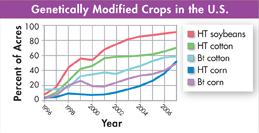Analyzing Data
Genetically Modified Crops in the United States
U.S. farmers have adopted GM crops widely since their introduction in 1996. Soybeans, cotton, and corn have been modified to tolerate herbicides and resist insect damage. The graph at the right summarizes the extent to which these crops were adopted between 1996 and 2007. The modified traits shown here include herbicide tolerance (HT) and insect resistance (Bt).
Analyze Data Which two crops were most widely and rapidly adopted?
Draw Conclusions Why do you think the levels of adoption fell at certain points over the period?
Predict What do you think will happen to HT soybeans and HT corn over the next few years? Why? Use the graph to support your prediction.
Infer Why do you think an increasing number of farmers have chosen to grow crops with herbicide tolerance?
GM Animals Transgenic animals are also becoming more important to our food supply. For example, about 30 percent of the milk in U.S. markets comes from cows that have been injected with hormones made by recombinant-DNA techniques to increase milk production. Pigs can be genetically modified to produce more lean meat or high levels of healthy omega-3 acids. Using growth-hormone genes, scientists have developed transgenic salmon that grow much more quickly than wild salmon. This effort makes it practical to grow these nutritious fish in captive aquaculture facilities that do not threaten wild populations.
When scientists in Canada combined spider genes into the cells of lactating goats, the goats began to manufacture silk along with their milk. By extracting polymer strands from the milk and weaving them into thread, we can create a light, tough, and flexible material that could be used in such applications as military uniforms, medical sutures, and tennis racket strings. Scientists are now using human genes to develop antibacterial goat milk.
Researchers hope that cloning will enable them to make copies of transgenic animals, which would increase the food supply and could even help save endangered species. In 2008, the U.S. government approved the sale of meat and milk from cloned animals. Many farmers and ranchers hope that cloning technology will allow them to duplicate the best qualities of prize animals without the time and complications of traditional breeding.
 In Your Notebook Describe the ways in which GM organisms can benefit agriculture and industry.
In Your Notebook Describe the ways in which GM organisms can benefit agriculture and industry.

FIGURE 15–14 Antibacterial Goat Milk Scientists are working to combine a gene for lysozyme—an antibacterial protein found in human tears and breast milk—into the DNA of goats. Milk from these goats may help prevent infections in young children who drink it. Apply Concepts What action do scientists hope the lysozyme gene will take in genetically modified goats?
Table of Contents
- Formulas and Equations
- Applying Formulas and Equations
- Mean, Median, and Mode
- Estimation
- Using Measurements in Calculations
- Effects of Measurement Errors
- Accuracy
- Precision
- Comparing Accuracy and Precision
- Significant Figures
- Calculating With Significant Figures
- Scientific Notation
- Calculating With Scientific Notation
- Dimensional Analysis
- Applying Dimensional Analysis





